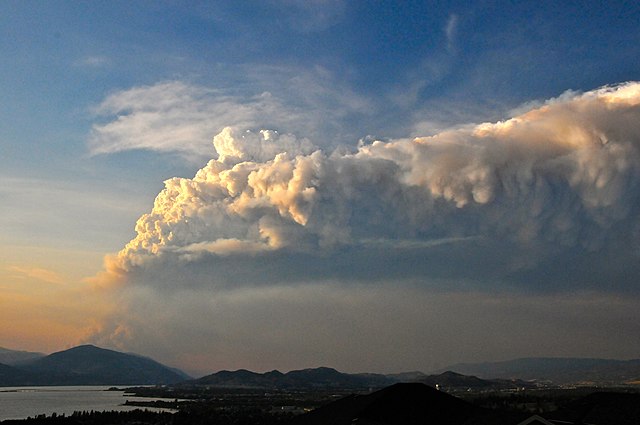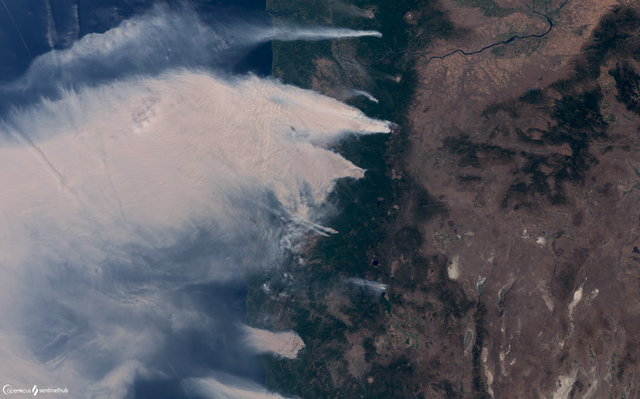Wildfire smoke has recently lofted enough soot across areas of the West to undo a large portion of the air quality improvements made over the last two decades, exposing millions of Americans each year to deadly levels of small particulate matter.
These are some of the conclusions of a recent Stanford University study on particle pollution known as PM2.5, which can enter into our bloodstream and lodge deep within our lungs, which was published in Environmental Science & Technology on September 22.
The researchers calculated PM2.5 concentrations specifically from wildfire smoke using statistical modeling and artificial intelligence methods in enough depth to highlight fluctuations within specific counties and specific smoke occurrences from coast to coast from 2006 to 2020.
Lead study author Marissa Childs, a Ph.D. candidate in Stanford’s Emmett Interdisciplinary Program in Environment and Resources, said, “We discovered that people are being exposed to more days with wildfire smoke and more extreme days with high amounts of fine particulate matter from smoke” (E-IPER). Wildfire smoke is classified as a “exceptional event” under the Clean Air Act, unlike other significant pollution sources, she said, “which implies an increasing fraction of the particulate matter that people are exposed to is uncontrolled.”
regular exposure to extremely smokey conditions

The authors, Childs and co-authors, were taken aback by how quickly the most extreme exposures went from being rare to commonplace.
More than eight million people now live in places with poor air, a 27-fold rise from the less than half a million who did so a decade earlier. To qualify as having unhealthy air, a day must have PM2.5 concentrations from wildfire smoke reaching at least 100 micrograms per cubic meter. Marshall Burke, a senior study author and an associate professor of Earth system science at the Stanford Doerr School of Sustainability, said, “That was considerably greater than I was expecting, and that’s the average across several recent years.” There have been many years that have been much worse, especially 2020.
With an 11,000-fold increase in the number of persons who experienced at least one day above 200 micrograms per cubic meter, the number of people exposed to the highest levels of pollution increased even more substantially. Two hundred microgram days were essentially unheard of ten years ago, according to Burke. More than 1.5 million people now reside in areas where these circumstances are “routinely” present.
According to census data, populations with higher incomes and those who are primarily Hispanic are experiencing increases in PM2.5 concentrations the fastest. This trend reflects the population makeup of the western and southwestern states, which have had the worst wildfire damage.
Putting a stop to wildfires

The writers’ goal was to comprehend how wildfire smoke affected society. “To do it effectively, you need long-term, local-level measurements of smoke exposure. Burke, a center fellow at the Freeman Spogli Institute for International Studies, Stanford Woods Institute for the Environment, and Stanford Institute for Economic Policy Research, claimed that those “didn’t exist.”
Childs, a postdoctoral fellow at Harvard’s Center for the Environment, said that smoke pollution is particularly difficult to assess because it is hard to determine what percentage of particulate matter is from smoking and because there are so few pollution monitors in the U.S. The Stanford researchers created a machine learning model with satellite data to precisely estimate PM2.5 concentrations from wildfire smoke in regions without sensors.
The resulting estimates have several advantages over earlier models, including the ability to compare them to long-term measurements from federal air quality monitors, quick prediction delivery after training, easy scaling to large areas, and the ability to avoid smoothing out the peaks of extreme smoke events.
Together, these developments mean that the Stanford model can assist researchers in understanding the societal effects of wildfire smoke pollution, including severe smoke events, which are becoming more frequent as the wildfire season is extended, fire frequency is accelerated, and burn areas are expanded due to climate change. “In what areas should we be particularly concerned? Who is truly being damaged, and at what levels of exposure does it matter? Without precise measurements of who is exposed to what, we can’t respond to those queries, Burke said.
The model, which the researchers are now updating with data from 2022, can help guide efforts to control air quality and reduce wildfires. Burke argues that “it’s crucial for regulators to understand what’s causing changes in air quality and to think about how we can alter existing laws to account for the reality that wildfires are playing a more significant role in determining air quality.”

